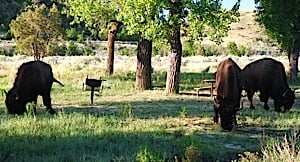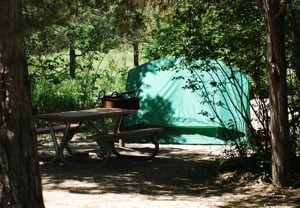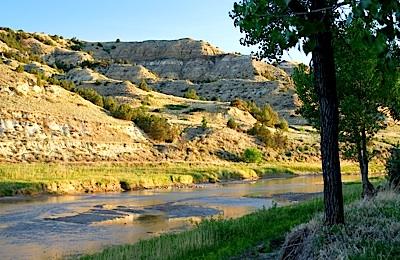Deciding where to pitch your tent or park your RV in Theodore Roosevelt National Park is pretty straightforward: If you're in the South Unit, you head for Cottonwood Campground. In the North Unit, the Juniper Campground is your destination.
But if you're flexible, you just might find you prefer a spot at Juniper.
Here's why:
* Both campgrounds are along the Little Missouri River that created the wonderful and curious badlands around which the park rose up.
* Both offer plenty of shady sites thanks to the tall stands of cottonwood trees that are so common along the river bottom.
* Both campgrounds offer campfire programs with rangers.
* Both campgrounds can bring you face-to-face with bison.
* Both offer grills and picnic tables at each site.
* Both are first-come, first-served.
But....
* Only at the Cottonwood Campground will you hear road noise from Interstate 94 that runs along the park's south boundary.
Cottonwood Campground
Looking at the park maps, you might not think you'd hear the trucks and cars that travel the interstate 24/7. But as Theodore Roosevelt Superintendent Valerie Naylor points out, those sounds can travel quickly up the Little Missouri River Valley when conditions are just right.
“You do hear the interstate noise in Cottonwood, and as a crow flies it's about 3 miles," she told me. "Really, it depends on the weather and the wind, but it travels long distances in the Little Missouri River Valley."

You could find yourself sharing your site with bison in the Cottonwood Campground. Kurt Repanshek photo.
When we pulled into the Cottonwood Campground, we didn't immediately notice the interstate noise. The wind was drifting through the treetops and rattling the leaves, and birds were chirping. The river was flowing, but it was too low for its gurgling to reach across the campground to where our site was.
But when I awoke during the night, it almost sounded as if we were camped within a half-mile of the interstate. And right around daybreak, when the birds were waking up and trading chirps, the interstate noise again intruded on the setting.
Aside from that, though, the 76-site Cottonwood Campground (11 are walk-in sites) is a solid basecamp for exploring the South Unit, and not just because it's the only campground in the unit.
Located near the southwestern corner of park's South Unit, the campground is a short drive from Medora and its restaurants, shops, and the park's Medora Visitor Center (where you'll find the cabin Theodore Roosevelt lived in during his time at the Maltese Cross Ranch). The South Unit's scenic loop drive also is just minutes away, as are many hiking trails (Paddock Creek Trail, Jones Creek Trail, Lone Tree Loop Trail, etc).
As I mentioned, there are nice stands of cottonwoods to provide shade throughout the day. And these trees attract birds, which in turn provide some nice background sound (in spite of the interstate noise). Sites 5 and 10 are handicap accessible.
You'll find four well-spaced restrooms with running water (cold) and flush toilets, (flush toilets work only during the main visitor season, though pit toilets are available year-round) and water spigots located in various spots.
Each site comes with its own picnic table and a spot or two to pitch a tent. (Somewhat curiously, when I stayed there one couple pitched their tent on the small area where you park your rig...). There's also a nice amphitheater for ranger talks.
There are no hookups for RVs, and no dump station, though there is a water-filling station in the campground. The nearest dump station is in Medora.
Fees are $10 per night during the main season, half that during the off-season. Plus, Senior Pass and Access Pass holders get a 50 percent discount.

Some Juniper sites are heavily vegetated. Kurt Repanshek photo.
Juniper Campground
This 50-site campground is located roughly 3 miles from the North Unit Visitor Center in a nice copse of cottonwoods. The Little Missouri meanders just west of the campground.
If you want river views, aim for a site between 28 and 44. Handicap sites are 1 and 3.
The many cottonwoods here seemed unusual to me in that many featured just one trunk, not a grouping of two or three, and they were nodding over like a lazy 'L." The sites are well-placed among the vegetation to offer the most privacy. Those that front the river are sandier than the others, and so might just offer better tent sites. You'll find a path down to the river between sites 40 and 42.
RVers will find a dump station operating during the main visitation season, as well as a water-filling site, but no hookups.
Pricing is the same at Juniper as at Cottonwood: $10 per night during the main visitation season, half that during the off-season, 50 percent discounts for Senior and Access pass holders.
From this basecamp you're directly across from the geologically intriguing "cannonball concretions" site. Within the campground you'll find a trailhead for the Achenbach Trail as well as one for the Little Mo Trail, which ties into the Buckhorn Trail, an 11-mile loop. With little work, you easily could piece together a backpacking trek beginning and ending at this campground.
Not far up the scenic drive you'll find the River Bend Overlook with its panoramic views of the Little Missouri, and beyond that (once the road is repaired), the Oxbow Overlook at road's end.
Unfortunately, neither campground offers campfire rings; fires, if you want one, need to be built in the upright grills.
Also, an issue here as in many other national park campgrounds is that there are no tent pads. Such pads -- box-shaped platforms typically filled with sand and free of rocks, roots, and other debris that could be painful to sleep on -- would not only give tenters a better setting on which to pitch their domiciles, but also would be easier on the environment. Vegetation would be saved, as would the ground, which can get chewed up by campers digging out roots and rocks for comfort's sake.
For planning purposes, you can find maps of the respective campgrounds at the park's website.


 Support Essential Coverage of Essential Places
Support Essential Coverage of Essential Places






